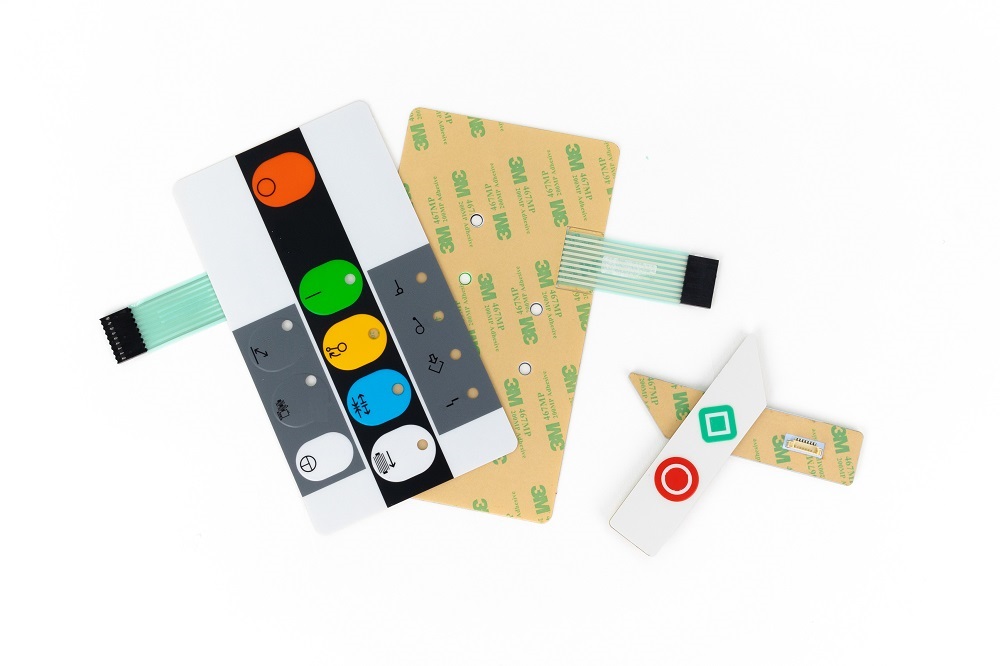Why Membrane Switches are Ideal for Durability and Performance
Why Membrane Switches are Ideal for Durability and Performance
Blog Article
Understanding Membrane Layer Switches Over: The Secret to Sturdy and Trusted Controls

What Are Membrane Switches?
Membrane layer switches are a sophisticated option in the world of customer interface modern technology, integrating functionality and design effortlessly. These tools serve as an interface between users and electronic systems, integrating a number of elements into a compact style. Normally created from adaptable, slim layers of products, membrane buttons are created to respond to touch, enabling individuals to connect with machinery and electronic devices efficiently.
The main aspects of a membrane layer button consist of a published circuit layer, graphic overlay, and a spacer layer that avoids unintentional activation. The graphic overlay can be tailored to mirror brand name identification or individual preferences, boosting aesthetic appeals while ensuring functionality. Membrane switches are generally made use of in different applications, consisting of clinical gadgets, consumer electronics, and commercial devices, owing to their sturdiness and resistance to environmental elements such as moisture and dirt.
One of the key benefits of membrane switches is their capability to stand up to wear and tear, making them ideal for high-traffic settings. Furthermore, they are lightweight and require minimal area, allowing for cutting-edge styles in product advancement. Overall, membrane layer switches stand for a reliable and functional choice for modern-day digital user interfaces, marrying innovation with user-centric design principles.
How Membrane Changes Work
The operation of membrane layer switches hinges on a straightforward yet effective mechanism that equates user input right into digital signals. When a user presses the switch, the top layer warps, permitting a conductive element in the circuit layer to make contact with a matching conductive pad on the bottom of the visuals overlay.
The layout of membrane buttons can differ, yet they typically include domes or responsive elements to supply responses to the customer, enhancing the overall experience - membrane switch. The materials utilized in membrane layer buttons, such as polyester or polycarbonate, add to their sturdiness and resistance to environmental aspects, consisting of wetness and dirt. Additionally, the published circuits are normally enveloped, which shields them from damage over time.
Benefits of Membrane Switches

In addition, membrane layer buttons are recognized for their sturdiness. Built from robust materials, they are immune to dirt, wetness, and physical this hyperlink wear, which considerably extends their lifespan compared to standard mechanical buttons. This durability makes them particularly suitable for high-traffic settings and applications requiring longevity.
An additional substantial advantage is the convenience of cleansing and maintenance. The smooth surface of membrane switches minimizes dust buildup and is often unsusceptible spills, making them optimal for settings that require frequent sanitization.
Moreover, membrane layer buttons provide a streamlined profile, leading to a thinner layout that can be incorporated into various tools without adding bulk. This feature not only enhances the visual charm however additionally contributes to an extra ergonomic item design.
Applications of Membrane Layer Buttons
Easy to use and versatile, membrane buttons discover applications across a vast array of markets, including clinical gadgets, customer electronic devices, and industrial equipment. In the medical area, these switches are integral to tools such as diagnostic tools, individual monitoring systems, and mixture pumps, where integrity and ease of cleansing are important. Their ability to stand up to extreme atmospheres and keep performance makes you could try this out them ideal for such applications.

In consumer electronic devices, membrane switches are utilized in items like microwaves, washing machines, and remotes - membrane switch. Their sleek style permits for instinctive user interfaces, improving the total customer experience while supplying durability and resistance to tear and put on
Industrial equipment likewise takes advantage of membrane switches, especially in control panels for equipment and automation systems. These buttons supply protection against dirt and moisture, guaranteeing regular performance in tough settings. Their customizable functions enable makers to customize them to certain functional demands, boosting performance and capability.
Picking the Right Membrane Layer Change
When choosing a membrane layer button, it is essential to consider numerous variables that affect efficiency and suitability for particular applications. go now The primary considerations consist of ecological conditions, tactile responses, toughness, and style specs.
First, evaluate the operating environment; buttons subjected to wetness, chemicals, or extreme temperatures call for specific products to make sure durability and functionality. Next off, assess the need for responsive comments. Depending on customer interaction, some applications may gain from a tactile feedback to verify activation, while others may favor a non-tactile style for aesthetic factors.
Longevity is one more vital factor; membrane layer switches need to be created to withstand regular use, effects, and abrasion. Ensure the picked switch can sustain the anticipated lifecycle, specifically in high-usage situations.

Verdict
In conclusion, membrane changes serve as necessary parts in the layout of trusted and sturdy control systems across various sectors. The flexibility of membrane layer changes allows for customized services that fulfill certain functional needs, strengthening their value in contemporary technology.
Membrane layer switches over stand for a crucial aspect of modern user interface layout, blending functionality with resilience in numerous applications.Membrane layer switches are an advanced option in the world of user interface innovation, combining performance and layout flawlessly. Typically constructed from versatile, thin layers of materials, membrane layer buttons are developed to respond to touch, enabling users to communicate with machinery and electronic gadgets efficiently.
The style of membrane layer switches can vary, however they usually integrate domes or responsive elements to give comments to the individual, enhancing the overall experience.In conclusion, membrane layer changes serve as necessary elements in the style of resilient and trustworthy control systems across numerous markets.
Report this page